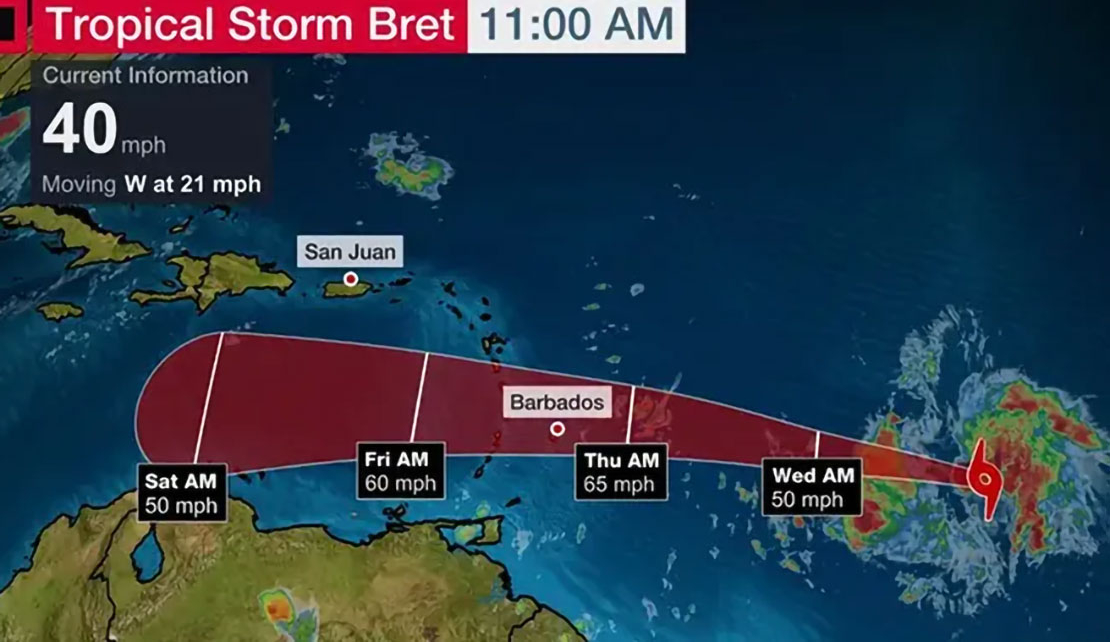June 20, 2023 - According to the National Hurricane Center, Tropical Storm Bret continues on a steady westerly track at 18 mph, as of the 8 p.m. advisory, and forecasters have announced a tropical storm watch for Barbados, St. Lucia and Dominica.
In their bulletin, NHC forecasters predict the Lesser Antilles to feel the effects of Bret by Thursday.
NHC dubbed the storm Bret as of 8 p.m. Monday, when it attained sustained winds of 45 mph, which it continues to have Tuesday.
“Models are split right now with either it curving north into the Atlantic or heading due west into the central Caribbean,” said WINK Chief Meteorologist Matt Devitt, on Monday. “It’s worth noting that the stronger it gets, it would be more likely to turn north.”
The Weather Authority is also following a new system off the coast of Africa that, as of the 2 p.m. advisory on Tuesday, has an 70% chance of development within the next 48 hours and 80% within a week.
The NHC reports, regarding this system, “a tropical depression will likely form during the next couple of days while the system moves westward at 10 to 15 mph across the eastern and central tropical Atlantic.”
Bret had maximum sustained winds of 45 mph (75 kph) and was moving across the Atlantic Ocean at 18 mph (30 kph), according to the National Hurricane Center in Miami, which warned that it’s been unable to get “a better handle on the system’s intensity and size.”
 Tropical SatellitebretThe storm was located some 780 miles (1,255 kilometers) east of the Windward Islands and is expected to pummel some eastern Caribbean islands on Thursday at near hurricane strength. A tropical storm watch was issued for Barbados, St. Lucia and Dominica, where the meteorological service said Tuesday that the storm poses a “high threat” to the island and warned of landslides, flooding and waves of up to 12 feet (4 meters).
Tropical SatellitebretThe storm was located some 780 miles (1,255 kilometers) east of the Windward Islands and is expected to pummel some eastern Caribbean islands on Thursday at near hurricane strength. A tropical storm watch was issued for Barbados, St. Lucia and Dominica, where the meteorological service said Tuesday that the storm poses a “high threat” to the island and warned of landslides, flooding and waves of up to 12 feet (4 meters).
“Landslides are highly likely as we are coming out of a relatively dry period where grounds may be compromised or developed cracks,” said Fitzroy Pascal with Dominica’s Office of Disaster Management.
Meanwhile, the hurricane center urged people in the Lesser Antilles, Puerto Rico and the Virgin Islands to closely monitor the storm and have their hurricane plans in place.
“Given the uncertainty in the track and intensity forecasts, it is too early to specify the location and magnitude of where Bret’s associated hazards could occur,” the center said.
Up to 10 inches (25 centimeters) of rain were forecast from the French Caribbean island of Guadeloupe south to St. Lucia, and up to 4 inches (10 centimeters) of rain for Barbados and St. Vincent and the Grenadines.
The government of Guadeloupe warned that inclement weather would start Wednesday evening and continue until late Friday, with waves of up to 10 feet (3 meters).
“Be careful!” officials warned in a statement.
Unfavorable winds and drier air are expected to later weaken Bret as it swirls through the central Caribbean region, with some models showing the storm could dissipate after affecting islands in the eastern Caribbean.
In the meantime, The Meteorological Service of Jamaica says the risk of threat for Jamaica from Tropical Storm Bret has been reduced due to the unfavourable conditions being encountered by the system. Bret is now expected to dissipate by weekend over the central Caribbean Sea.
The storm formed Monday — an early and aggressive start to the Atlantic hurricane season that began on June 1. A tropical disturbance with an 80% chance of cyclone formation is trailing Bret. No June on record has had two storms form in the tropical Atlantic, according to meteorologist Philip Klotzbach at Colorado State University.
The National Oceanic and Atmospheric Administration has forecast 12 to 17 named storms for this year’s hurricane season. It said between five and nine of those storms could become hurricanes, including up to four major hurricanes of Category 3 or higher.
Virginia Tech meteorologist Stephanie Zick said she expects to see a higher than average number of storms rapidly intensify this season given warmer sea surface temperatures. She also noted that flooding from tropical systems that make landfall has caused the most deaths in the past 10 years.
“The hazards associated with tropical storms can occur hundreds of miles away from the storm center,” she said.



